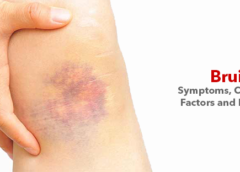What is a Bruise?
You’ll fall off your bike, bang your shin on the coffee table (which you swore you’d be moving months ago), or run into a wall and wake up with a bruise. A bruise is caused by damaging or fracturing tiny blood vessels as a result of damage to the skin (be it bumping into something or hitting yourself with a hammer). The elevated area of a bump or bruise is the result of blood leakage into the tissues from these injured blood vessels, as well as the body’s response to the injury. Medically, a bruise has termed a contusion. A purplish, flat bruise that happens when blood spills out into the skin’s top layers is called an ecchymosis.
What are the symptoms and signs of bruises?
Bruise signs vary according to cause. Discoloration of the skin is often the first sign. While they’re usually black and blue, bruises can also be:
- Red
- Green
- Purple
- Brown
- Yellowish, that is most often seen when bruise heals
You can also feel discomfort and tenderness when it comes to bruising. These symptoms generally improve as the bruise heals.
When to call your doctor
Easy bruising is a medical emergency if there is a large, massive bruise under the skin which appears to bleed continuously.
Organ injuries are also an emergency, so if a person is having a hard blow to the back, chest or stomach, if a bruise is very painful, or if it is unusually black or swollen, he should go to the emergency room.
However, in most cases, it is safe to wait to see if a bruise is resolving by itself.
People should consult with a doctor regarding easy bruising if:
- Suddenly they start to bruise more easily than before
- Other symptoms include yellow skin, fever, low energy or skin changes
- They take medications and tend to bruise more easily
- They get a lot of painful bruises which are very sluggish to heal
Causes of a Bruise
People get bruises usually when they bump into something or when something bumps into them.
- Some people, who practice vigorously, such as athletes and weight lifters, may experience bruises. These bruises are the result of microscopic tears in the under-skin blood vessels.
- A bleeding disorder may be indicated by unexplained bruises that occur easily or for no apparent reason, especially when the bruise is accompanied by frequent nosebleeds or bleeding gums.
- Often, what are thought to be unexplained bruises on the shin or thigh, for instance, are caused by bumps into a bedpost or other object and fail to recall the injury.
- Bruises also occur in the elderly, as their skin has become thinner with age. The tissues that support the underlying blood vessels have become more fragile.
- Bruises are also more prevalent in those taking blood-thinning medicines.
Risk Factors for Bruising
A contusion is the result of blunt force contacts, such as a fall or a direct blow. The force crushes small blood vessels beneath the skin, and sometimes the muscle fibres and connective tissue without breaking the skin. Your body normally stops the bleeding quickly, but a small amount of blood often leaks into surrounding tissues and under the skin, forming a visible bruise.
The following risk factors increase a person’s likelihood of bruising easily:
- Age greater than 50
- Anticoagulant and antiplatelet medications, such as aspirin and warfarin (Coumadin)
- Bleeding disorders due to liver disease, vitamin K deficiency, or an inherited condition
- Blood vessel defects
- Platelet disorders
Complications
Bruising-related complications may be progressive and differ according to the underlying cause. Since serious illnesses may cause simple or unexplained bruising, failure to seek care may lead to complications and permanent harm. It is important to contact your health care provider when you experience any kind of persistent or recurrent bruising or bleeding symptoms, such as lacerations or cuts that take a long time to stop bleeding. Once the underlying cause is diagnosed, following the treatment plan outlined by your doctor can lower your risk of potential complications including:
- Coma due to brain contusion or hematoma
- Compartment syndrome (a complication of severe muscle bruise)
- Hematoma
- Hypovolemic shock and coma due to contusions or hematomas of organs such as the liver or spleen
- Risk of fracture, especially in the elderly
How can bruises be prevented?
Even among healthy children and adults bruises are a common problem. Even they cannot be avoided absolutely, you can decrease the chance of bruises in the following ways:
- Keep furniture away from doorways or walkways where you might bump into it.
- Carry a flashlight to reduce the chance of accidental falls while walking through poorly-lit areas.
- Keep the floors and walkways clear of obstacles (such as throw rugs) which may cause you to slip and fall.
- When playing contact sports or riding a motorcycle wear helmets or other protective equipment.
- Keep a night light on in case you need to get up during the night to go to the bathroom.
- Make sure your diet contains adequate amounts of vitamins B12, C, and K, and folic acid.

Leave a Reply
You must be logged in to post a comment.